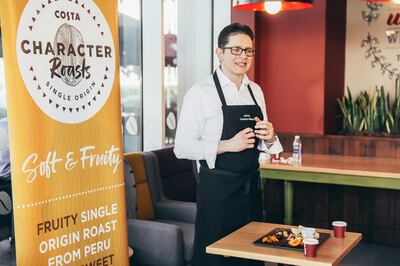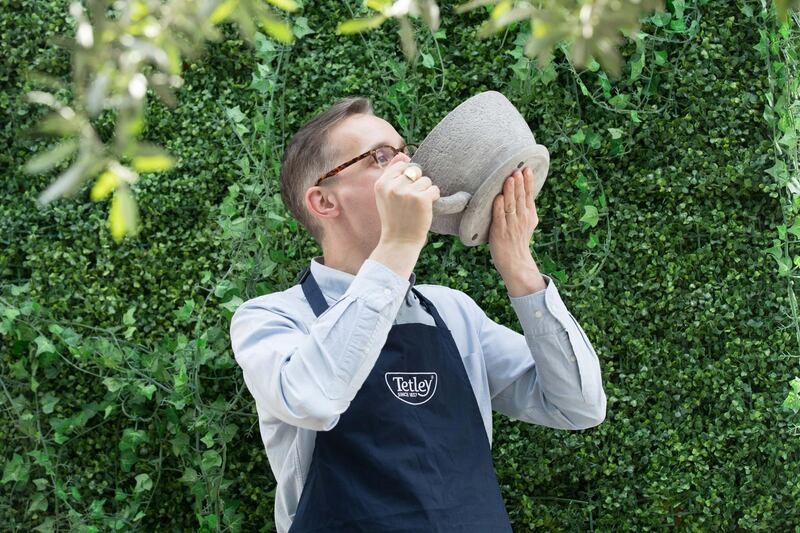A few weeks ago, the UAE welcomed two men with rather discerning tastes. Sebastian Michaelis, a master tea taster at Tetley, and Gennaro Pelliccia, a master coffee taster for Costa, are so proficient at their jobs that their tongues have been insured for US$1 million (Dh3.7m) and £10m (Dh51m), respectively.
Why have their tongues insured?
“It takes at least five years to qualify as a professional taster, which also involves spending a whole year with tea producers around the world to understand every aspect of the beverage, from crop to cup,” says Michaelis, who was in the UAE earlier this month to launch two varieties of Tetley Loose Leaf. “The insurance, really, is a reflection of the amount of time, effort and money spent on my training, which ensures that I can recognise thousands of varieties, having sipped from hundreds of thousands of cups.”
According to Pelliccia, who conducted a coffee masterclass in Dubai last month, the insurance policy also works as a guarantee to the millions of customers who can be assured that they’ll get the same flavour and taste each time they order their favourite cup of coffee. “Take our Mocha Italia, for example. It’s a blend and a well-guarded industry secret, but it’s necessary to ensure that the taste profile is maintained. Elements such as climate and rainfall can affect the taste of the bean, which us tasters then need to account for,” he says.

How the taste buds work
One of the five tangible human senses, taste works alongside our sense of smell to communicate to the brain whether or not a particular flavour or food is enjoyable or even just palatable. Located on the tongue are thousands of bumps that house hundreds of taste buds, each of which contains at least 50 taste-receptor cells. The sensations that we experience – primarily sweetness, sourness, saltiness, bitterness and savouriness, or umami – are brought on by the chemical reaction between these cells and what we put in our mouths.
To this, professionals such as Michaelis and Pelliccia bring elements of acquired and “super” tastes. The former is a matter of frequency; the more you expose your taste cells to a particular food or drink, the higher your chances of both appreciating it and being able to distinguish its nuances. Black coffee is a good example. Not many first-time drinkers become instant fans, but the longer they endure its strong odour and bitter taste, the more likely they are to get used to and even addicted to its peculiar flavour. Supertasters, meanwhile, biologically have an increased number of bumps, which are called papillae, on their tongues, and roof, sides and back of the mouth. Consequently, their gustation is much more acute and – as an aside – they can get an equal level of satisfaction from far less fat and sugar in their food, compared to average tasters. Just another reason to train your taste buds, then.
Practice makes (taste) perfect
“Practise, practise, practise,” confirm both Pelliccia and Michaelis, who adds: “The only way to get good at tasting drink or food, is to try it a lot. You can learn a huge amount by trying lots of different varieties and then tasting them together to pick out the differences. Most importantly, if you recognise a flavour or character, try and describe or name it. This makes it much easier to remember that character the next time you come across it,” he explains.
Michaelis also notes that while hot curries and other strong-tasting foods do not harm or restrict the long-term ability of the mouth’s receptor cells, he only ever indulges in these outside of work. “I do have to restrict what I eat at work to relatively bland food, so as not to interfere with my taste buds. During the day, I limit myself to porridge in the morning with a cup of tea, and a light salad and crackers in the afternoon. It’s always best to taste early in the day, when your tongue is most sensitive,” he says.
Pelliccia adds: “I need to be mindful about what I eat, especially before a cupping session at our roastery in the UK, as certain spices or strong flavours such as garlic can affect my ability to taste properly. We are also very careful to ensure that our senses are not compromised. For instance, the team all wear lab coats to protect against contamination, and ensure that we only pass the cups of coffee on saucers, so the flavours are not even slightly influenced by, say, a hand cream or perfume.”
Taste snobbery?
Given their highly developed tastes, I wonder what the two experts make of the kinds of beverages offered by mass chains, and whether it’s possible for such franchises to consistently serve a world-class cuppa? Much like our altering tastes and moods, though, it turns out that quality is extraneous when it comes to the two drinks. From English Breakfast in a tea bag to herbal infusions and artisanal whole leaves, each tea leaf has different characteristics and suits different palates. The same goes for coffee beans.
“I think there’s a tea for every taste and occasion. I don’t only drink the most expensive or exclusive blends, preferring a strong cup of black tea, ideally a robust Kenyan, with milk in the morning using a tea bag, green tea in the afternoon, and mint tea in the evening,” says Michaelis. “It all depends on what mood you are in. There’s no best or worst, they are all just different.”
______________________
Read more:
14 new brunches to try in the UAE
Your definitive (and constantly updating) list of things to do in Dubai
On fermented food in the UAE: Where to find it and why you should eat it
______________________







